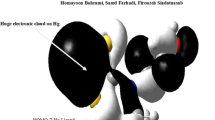Abstract
Ab initio molecular orbital theory with triple-zeta-valence plus polarization basis sets and with electron correlation incorporated at the fourth-order Møller-Plesset level has been used to study the tetrahydridoonium dications, OH4 2+, SH4 2+, and SeH4 2+. The tetrahydridoselenonium dication SeH4 2+ is predicted to have a tetrahedral (T d )structure, similar to OH4 2+ and SH4 2+, with short bonds to hydrogen (1.483 Å). Although deprotonation of SeH4 2+ is thermodynamically favored Cby 104 kJ mol−1), such a reaction is inhibited by a large barrier (240kJmol−1]. Thus, SeH4 2+ lies in a deep potential well and as an isolated species should have a long lifetime in the gas phase. The estimated heat of formation, ΔH° f , for SeH4 2+ is very high (2483 kJ mol−1], as is the case for OH4 2+ and SH4 2+. Of the group IV onium dications (OH4 2+, SH4 2+, and SeH4 2+), SeH4 2+ displays the greatest kinetic and thermodynamic stability toward proton loss. Substantial solvent stabilization is required in order to generate SeH4 2+ in solution.
Similar content being viewed by others
References
For a recent review, see: Koch, W.; Schwarz, H. InStructure/Reactivity and Thermochemistry of Ions, Ausloos, P.; Lias, S. G.; Eds.; Reidel: Dordrecht, 1987.
Koch, W.; Heinrich, N.; Schwarz, H.; Maquin, F.; Stahl, D.Int. J. Mass Spectrom. Ion Processes 1985,67, 305.
Olah, G. A.; Prakash, G. K. S.; Barzaghi, M.; Lammertsma, K.; Schleyer, P. v. R.; Pople, J. A.J. Am. Chem. Soc. 1986,108, 1032.
Olah, G. A.; DeMember, J. R.; Mo, Y. K.; Svoboda, J. J.; Schilling, P.; Olah, J. A.J. Am. Chem. Soc. 1974,96, 884.
Bollinger, J. C.; Faure, R.; Yvernault, T.; Stahl, D.Chem. Phys. Lett. 1987,140, 579.
Olah, G. A.; Prakash, G. K. S.; Marcelli, M.; Lammertsma, K.J. Phys. Chem. 1988,92, 878.
Laali, K.; Chen, H. Y.; Gerzina, R. J.J. Organomet. Chem. 1988,348, 199.
Hehre, W. J.; Radom, L.; Schleyer, P. v. R.; Pople, J. A.Ab Initio Molecular Orbital Theory; John Wiley: New York, 1986.
Nobes, R. H.; Smith, B. J.; Riggs, N. V.; Wong, M. W. Unpublished.
Baker, J.J. Comp. Chem. 1986,7, 385.
Baker, J.J. Comp. Chem. 1987,8, 563.
Frisch, M. J.; Binkley, J. S.; Schlegel, H. B.; Raghavachari, K.; Melius, C. F.; Martin, R. L.; Stewart, J. J. P.; Bobrowicz, F. W.; Rohlfing, C. M.; Kahn, L. R.; DeFrees, D. J.; Whiteside, R. A.; Fox, D. J.; Fluder, E. M.; Pople, J. A.GAUSSIAN 86; Carnegie-Mellon University: Pittsburgh, PA 15213.
Møller, C.; Plesset, M. S.Phys. Rev. 1934,46, 618
Pople, J. A.; Binkley, J. S.; Seeger, R.Int. J. Quantum Chem. Symp. 1976,10, 1.
Wong, M. W.; Gill, P. M. W.; Nobes, R. H.; Radom, L.J. Phys. Chem. 1988,92, 4875.
Dunning, T. H., Jr.J. Chem. Phys. 1977,66, 1382.
Harmony, M. D.; Laurie, V. W.; Kuezkowski, R. L.; Schwendeman, R. H.; Ramsay, D. A.; Lovas, F. J.; Lafferty, W. J.; Maki, A. G.J. Phys. Chem. Ref. Data 1979,8, 619.
Gill, P. M. W.; Radom, L.J. Am. Chem. Soc. 1988,110, 5311.
Pople, J. A.; Schlegel, H.; Krishnan, R.; DeFrees, D. J.; Binkley, J. S.; Frisch, M. J.; Whiteside, R. A.; Hout, R. F.; Hehre, W.J. Int. J. Quantum Chem. Symp. 1981,15, 269.
Krishnan, R.; Pople, J. A.Int. J. Quantum Chem. 1978,14, 91.
Krishnan, R.; Frisch, M. J.; Pople, J. A.J. Chem. Phys. 1980,72, 4244.
Cooks, R. G.; Ast, T.; Beynon, J. H.Int. J. Mass Spectrom. Ion Phys. 1973,11, 490.
Ast, T.Adv. Mass Spectrom. 1980,8A, 555.
The experimental heat of formation of H+ is 1528 kJ mol−1: Rosenstock, H. M.; Draxl, K.; Steiner, B. W.; Herron, J. T.J. Phys. Chem. Ref. Data 1977,6, Suppl. 1.
Lias, S. G.; Liebman, J. F.; Levin, R. D.J. Phys. Chem. Ref. Data 1984,13, 695.
Gill, P. M. W.; Radom, L.Chem. Phys. Lett. 1987,136, 294;
Gill, P. M. W.; Radom, L.Chem. Phys. Lett. 1988,147, 213;
Radom, L.; Gill, P. M. W.; Wong, M. W.Int. J. Quantum Chem. Symp. 1988,22, 567.
Author information
Authors and Affiliations
Rights and permissions
About this article
Cite this article
Wong, M.W., Radom, L. Structure and stability of the tetrahydridoselenonium dication, SeH4 2+ . Struct Chem 1, 13–18 (1990). https://doi.org/10.1007/BF00675779
Received:
Accepted:
Issue Date:
DOI: https://doi.org/10.1007/BF00675779




